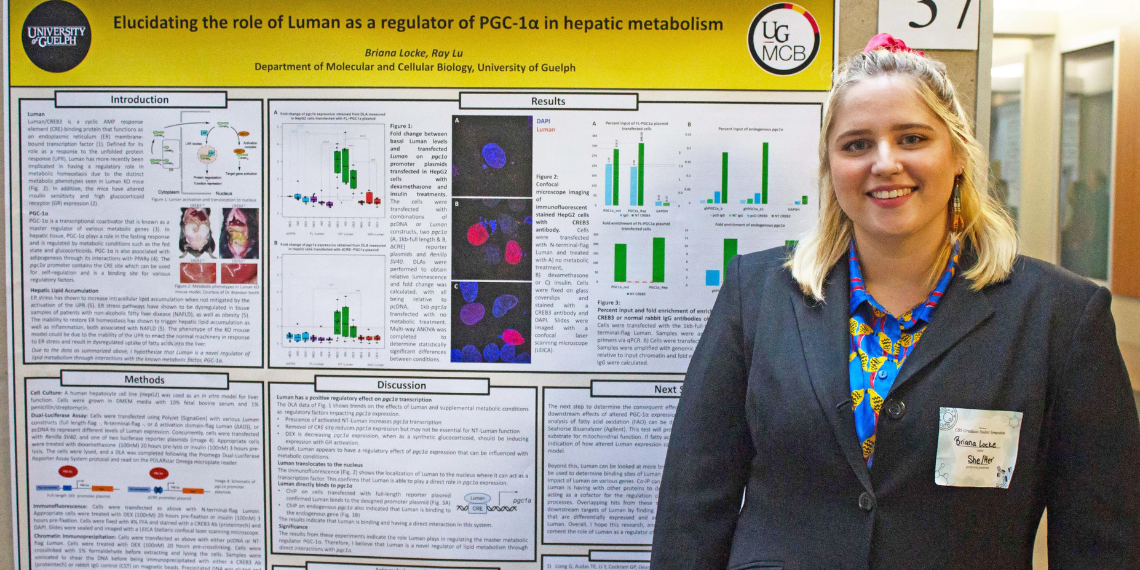Uncovering a Piece to the Metabolism Puzzle: Study Reveals Novel Regulator of Energy Metabolism

Have you ever wondered why rates of metabolism can differ so widely from person to person? Some people can indulge in rich foods without negative metabolic consequences, while others must carefully watch their diet. Although the exact reasons for these differences remain unknown, researchers in the Department of Molecular and Cellular Biology have discovered a new molecular interaction that could play a key role in this metabolic mystery.
“Understanding the cellular mechanisms that underlie metabolism is essential to understanding what constitutes ‘metabolic health,’” says Dr. Briana Locke, a recent PhD student who authored the study with Dr. Ray Lu.
Balancing energy intake and consumption, or energy homeostasis, is a critical regulatory process. Energy homeostasis differs from cell to cell, with some parts of the body requiring more energy than others. Lipids and carbohydrates can both be metabolized to provide fuel when needed, but lipids make up the body’s primary energy reserves. Dysregulation in lipid metabolism (and, by extension, energy homeostasis) can cause metabolic disorders like cardiovascular disease, diabetes and obesity – all of which are becoming increasingly prevalent.
Locke and Lu have now confirmed a new regulatory protein involved in energy homeostasis, CREB3, that sheds new light on this complex metabolic process.
CREB3, also known as Luman, was first discovered by Lu more than 25 years ago when he was studying cellular stress as a post-doctoral fellow. Since that time, Lu and others have gone on to elucidate the important role of CREB3 in regulating the body’s response to stress. Recently, however, Lu and colleagues noticed that genetically engineered mice deficient in CREB3 had not only a “blunted” stress response, but also exhibited a lean body type and were protected from weight gain when fed a high-fat diet. These findings hinted that the protein was involved in other key metabolic processes as well.
Published in FEBS Letters, Locke and Lu’s study uncovers a specific role of CREB3 in energy metabolism. Working with human liver cells, the researchers found a definitive link between CREB3 and a “master regulator” protein, PGC-1α, which is involved in the control of major energy pathways, such as mitochondrial activity and the breakdown of lipids.
More specifically, they examined a regulatory region of DNA within the PGC-1α gene where CREB3 is likely to bind. At this binding site, CREB3 acts as a control factor, influencing the gene’s activity. While CREB3 was shown to mediate PGC-1α gene activity, increased levels of CREB3 in cells were also linked to repression of the gene – showing that CREB3 is a regulator of PGC-1α.
The authors note that there are other cell factors that can mediate the interaction between CREB3 and PGC-1α, further highlighting the intricate regulatory processes and feedback loops that can be involved in energy metabolism. One such factor studied in the Lu lab is stress hormone, glucocorticoids (i.e., cortisol), which impacts PGC-1α regulation. Glucocorticoids have also been shown to be influenced by CREB3, further highlighting the influence CREB3 has on PGC-1α and metabolism. While more research remains to be done, confirming the role of CREB3 in energy metabolism represents a significant step forward.
By understanding the complex role of CREB3, the researchers hope to gain new insights into metabolic disease, which in turn may someday lead to new clinical treatments that involve or target CREB3.
“By identifying CREB3’s specific role in stress response, pharmaceutical targets can be identified to develop mediating interventions that can treat disease such metabolic disorders and mental health problems that have gained prominence in today’s society,” says Lu.
“CREB3 is clearly an important protein and one day, we hope to fully determine how CREB3 affects metabolic health,” explains Locke.
Read the full study in the journal FEBS Letters.
Read about other CBS Research Highlights.